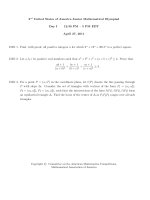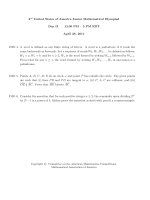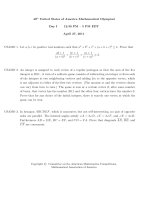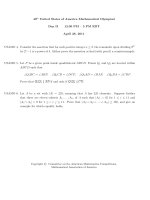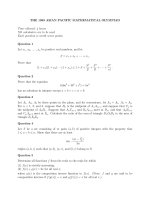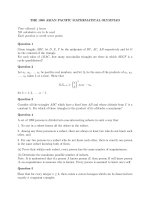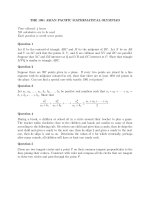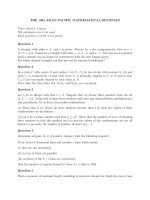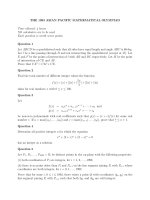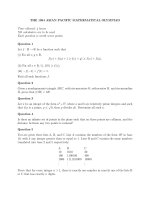ĐỀ THI TOÁN APMO (CHÂU Á THÁI BÌNH DƯƠNG)_ĐỀ 25 pps
Bạn đang xem bản rút gọn của tài liệu. Xem và tải ngay bản đầy đủ của tài liệu tại đây (49.26 KB, 1 trang )
THE 1989 ASIAN PACIFIC MATHEMATICAL OLYMPIAD
Time allowed: 4 hours
NO calculators are to be used.
Each question is worth seven points.
Question 1
Let x
1
, x
2
, . . . , x
n
be positive real numbers, and let
S = x
1
+ x
2
+ · · · + x
n
.
Prove that
(1 + x
1
)(1 + x
2
) · · · (1 + x
n
) ≤ 1 + S +
S
2
2!
+
S
3
3!
+ · · · +
S
n
n!
.
Question 2
Prove that the equation
6(6a
2
+ 3b
2
+ c
2
) = 5n
2
has no solutions in integers except a = b = c = n = 0.
Question 3
Let A
1
, A
2
, A
3
be three points in the plane, and for convenience, let A
4
= A
1
, A
5
= A
2
.
For n = 1, 2, and 3, suppose that B
n
is the midpoint of A
n
A
n+1
, and suppose that C
n
is
the midpoint of A
n
B
n
. Suppose that A
n
C
n+1
and B
n
A
n+2
meet at D
n
, and that A
n
B
n+1
and C
n
A
n+2
meet at E
n
. Calculate the ratio of the area of triangle D
1
D
2
D
3
to the area of
triangle E
1
E
2
E
3
.
Question 4
Let S be a set consisting of m pairs (a, b) of positive integers with the property that
1 ≤ a < b ≤ n. Show that there are at least
4m ·
(m −
n
2
4
)
3n
triples (a, b, c) such that (a, b), (a, c), and (b, c) belong to S.
Question 5
Determine all functions f from the reals to the reals for which
(1) f(x) is strictly increasing,
(2) f(x) + g(x) = 2x for all real x,
where g(x) is the composition inverse function to f(x). (Note: f and g are said to be
composition inverses if f(g(x)) = x and g(f (x)) = x for all real x.)
